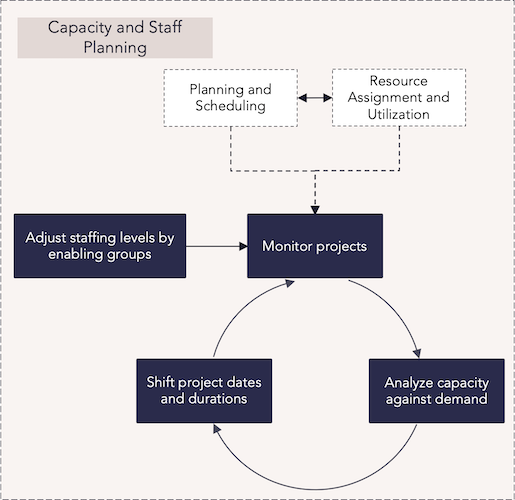AdaptiveWork process flows
Overview
This guide walks you through the essential steps of capacity and staff planning in Planview AdaptiveWork, helping your organization stay flexible and ready to respond to shifting demand. It contains helpful best practices and reporting insights designed to support smarter, more strategic staffing decisions. You’ll learn how to assess resource availability, keep an eye on project staffing, and make timely adjustments to allocations based on both current and upcoming needs. Whether you're refining your process or just getting started, this guide is here to help you make the most of your team’s capacity.
Process steps

| Process step | Description |
|---|---|
| Adjust staffing levels by enabling groups |
Assess the resource availability and capacity of user groups over time by resource group, job title, or user in the Capacity Planning view. You can assess your user group’s capacity and utilization as a whole or by individual members for deeper analysis. Capacity is represented as FTEs, working hours, or person days. User groups are configured by the administrator and are available to one or more resource managers designated for those groups. For example, a user group configured for the North America West Region would exclude other regions. For more information: |
| Monitor projects |
Review the data visualizations in the Capacity Planning tab to monitor how your resources are distributed and utilized, both currently and over time. You can track active and requested projects, display resource capacity, and view resource utilization as a percentage of the total capacity. For more information: |
| Adjust staff allocations based on demand |
Adjust how your resources are distributed by reviewing open requests, remaining availability, and the total capacity of assigned and unassigned resources to determine where resources are needed most at a given time. In the Reports tab, you can view the Utilization report to compare estimated versus actual utilization by month and task. You can view and use resources from other groups and subgroups if your current resources are fully utilized. If your resources don’t have the skills required for a project, you can filter and select resources by their skillset. Discuss resource requests with the project manager using the Discussions feature. For more information: |
| Shift project dates and durations |
If appropriate, you can shift your project’s start and end date to maximize resource capacity and adapt to changing plans. Staffing requests and project assignments shift relative to new start dates, so make sure to manually update these if needed. You can customize rules to automate resource shifting when you adjust start or end dates. For more information: |
Reports
There are several standard resource load and utilization reports in the report library. These can be run with specific filters to see the appropriate resourcing information. See the Resource Utilization Report for more information.
Additional reports and dashboards can be created by the administrator and shared with the organization and appropriate team members.
Best practices
Organize capacity pipelines
Viewing the organization’s capacity through the lens of a single resource hour pipeline will lead to some resources being overutilized and others being underutilized. Sort resources into smaller pipelines that fit your organization’s operating model such as regions, departments, practices, or teams to help account for the different types of work that exist.
Prioritize mid-range forecasting
For organizations focused on billable work, demand will fluctuate over time, with the organization adjusting the capacity and staffing plan to match the changes in demand. Visibility and accuracy are crucial for this planning to be effective. Ensure you can correctly forecast demand six to eight months in advance so the organization can grow or shrink resource capacity and account for the impacts of hiring or contract decisions.
Establish partner resources
Services organizations typically do not want to turn away opportunities, instead adding additional capacity using a mix of full-time employees, contractors, and consultants to match demand as it increases or decreases. Having a pre-established relationship with partners included in the capacity plan allows the organization to adjust the utilization of these different types of resources as demand changes or disruptions occur.
Strategically overestimate
When calculating resource capacity and forecasting velocity within a services organization, it can be beneficial to slightly overestimate capacity, especially if mid- to long-range forecasting is accurate. Overestimating – within reasonable bounds – ensures that the organization always takes in the maximum demand, helps maintain relationships with consultant and contractor partners, and allows the organization to identify steady trends that justify growing the organization’s staff.
Expect and alleviate disruption
In services organizations, surprise sales and increasing scope are constant possibilities. Project managers should always be prepared to revisit the staffing plan to alleviate this potential for disruptions, usually by assigning established contractor and consultant partners or by looking across the organization for resources with the most availability.
Generate consistent reporting
Having access to reliable and up-to-date information means that leadership can make informed decisions when planning, prioritizing, and reprioritizing work. Reports and dashboards can provide quick, real-time visualizations to help with planning and prioritization, calling attention to staffing issues that require resolution.

